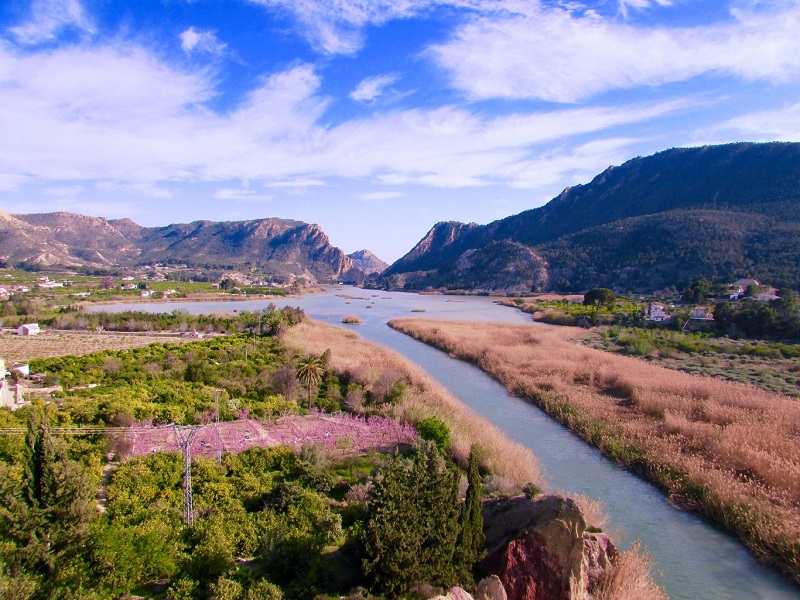
The splendid Valle de Ricote, also known as the Morisco Valley as the last redoubt of Muslims in Spain after the Reconquest, is a fertile territory with a flourishing past, characteristics that make it attractive when it comes to enjoying nature and Culture, gastronomy and even health tourism.
In the province of Murcia, it occupies an area of approximately 144 square kilometers, with the central axis of the river Segura and its distance to the city of Murcia is about 30 kilometers. If you do not know the area, we invite you to our selection of 15 experiences to discover the Valle de Ricote.
This area is one of the most populated during the Middle Ages, especially during Muslim domination, when Mudejar and Moorish flourished, in fact its etymology was probably explained by the name of the emperor of Ricut (around the thirteenth century).
The explanation for this large settlement is on the Segura River, which turns this area of the Vega Alta River into a vineyard, a fertile landscape of fruit trees, orchards and palm trees, surrounded by steep cliffs that for centuries served as a defensive fortress and today We invite you to visit them for the best views.
From east to west, the municipalities of Archena, Villanueva, Ulea, Ojós, Ricote, Blanca and Abarán cross the valley, although Cieza is always considered an “unofficial” part of the Valley due to the fact that it constitutes its western entrance.

Archena, a spa and much more
We start in Archena, the nearest town to Murcia capital, just 27 kilometers. The spring of thermal water that pops up to a few kilometers of the urban nucleus mark the fame of this locality.
- Balneario de Archena, this population is mainly known for its spa between gardens on the banks of the river Segura. The spa of Archena has thermal springs already used in Roman times and is currently a complex with three hotels, among which the most outstanding is the Hotel Termas, which preserves part of the decoration of the last century in neo- Nazari In the enclosure we find all the health treatments, cosmetics, spa, swimming pools … for your guests and visitors.
- The Museum of Archena is a modern glass building, where you can admire the archaeological and historical remains of Archena along with other historical riches of the area and discover through it the true history of the Thermal Villa of Archena.
- Esparto Museum, located in the beautiful Palace of Villarías, is the curious Museum of Esparto, in which we learn about the use of this material, so important in the area. Replicas of monuments, costumes or objects that could well have been among the Dadaist creations, it is best that this space retains a craft mode of working esparto, probably used since prehistory.
- Besides, I would not bid farewell to Archena without visiting the poet Vicente Medina’s walk along the left bank of the Segura River, between waterwheels, viewpoints and verses.
You may also like to read another article on NGCATravel: Visit to Dinópolis in Teruel, land of dinosaurs
Ulea
- In Ulea we can walk to the Gurugú, a place where there is a small farmhouse with a recently restored Arabic style tower. Its owner, an Ulean soldier who participated in the battle of Morocco, returned to Ulea and built this building in 1870 (19th century) similar to the one in North Africa. Here, among palm trees, pines and oleanders, we have a magnificent viewpoint over the river and Ulea. Other stops in Ulea are the Church of San Bartolomé (XVI century), located in the highest part of the municipality, the Pila de la Reina Mora and the Plaza del Henchidor.
What to see in Ojós
- The environment of Ojós gives us a good clue of where its name comes from: the Arabic “huxus”, the orchards. The Moorish past can be seen in Ojós in the layout of its streets and in the taste for the tradition of baking. Ojós is a small village of 600 inhabitants in the middle of the valley. Here the most sweet ones will taste the drunken biscuits of Ojós, a sweet of secret recipe that can be taken in the peculiar local of Marilí, that next to his daughter will make of hosts and will tell the history of the biscuits, realized artisan in oven of firewood ( They will tell us everything except their coveted recipe, of course). We continue the walk through the laundry, through its colorful streets, with manor houses, we approach the river and its small photogenic suspension bridge.

Blanca: The best views of the Ricote valley over the river
We continue towards the interior of the valley and we stop in White. We cannot speak of this population without knowing a curiosity about its name. Formerly called Black by the Arabs, but with Christian domination they wanted to do a total “wash” (never better) and change the name to its antonym. However, the original name is the one that makes the most sense, since the locality sits on a rock of dark tonality.
- In Blanca we delight in the best views of the valley on the river Segura: in the viewpoint of Alto de Bayna (cover photo). We are on a floating metal walkway built on the rock of Bayna. Here we are captivated by the panoramic views of the river Segura flanked by hurdle and the Embalse o Azud de Ojós.
- La Via del Arte is a tourist project that consists of a route through the town center that guides us through the town’s routes, between sculpture, photography and painting. In the Via del Arte we can also include a visit to the Center for Interpretation of Water and Light or the cultural complex of the MUCAB.
You may also like to read another article on NGCATravel: Trip to Oslo with children: Five museums to enjoy with family
The Route of the Norias of Abarán
- In Abarán we take a relaxing walk along the Route of the Norias in an idyllic setting , dominated by water and among orchards and fruit fields. There are four hydraulic mills that we find, among them the Big Ferris wheel, which dates from 1805 and is the largest in Spain in use. Again we get that Moorish flavor of the valley, since it was the ancient settlers who introduced their use in the area. Also in Abarán we can go to the Mirador de los Santos Doctors or to the Cabezo de la Cruz or to the Sanctuary of the Virgen del Oro and enjoy the views of the Valley.
Cieza Holidays
We go to the town of Cieza, which, although not formally part of the Valle de Ricote, being located at one of its ends forms a natural part of our route and obligatory stop. Cieza is 43 kilometers from the city of Murcia. We are already talking about the natural spectacle of the flowering of Cieza and this certainly is already attractive enough to approach Cieza. But, given its ephemeral nature, we are going to stay with other experiences available all year.
As we have said, Valle de Ricote was the last Moorish stronghold of the Iberian Peninsula, when the order of its expulsion was executed in 1609. For 800 years, it became a very important nucleus within Al-Ándalus, with a cultural richness that marveled at figures like Alfonso X the Wise. Hence, the Arab culture and its fusion with Christianity will leave a mark that reaches today and this can be clearly seen in Cieza.
- The Siyâsa Medina. To understand the past of Cieza nothing better than to know Siyâsa, which is its original nucleus. The Medina Siyâsa is on the outskirts of Cieza, on the Cerro del Castillo and is the remains of a Muslim village from the 11th century. It is the most important archaeological site in Islamic decoration of Europe, although seeing its remains we do not have an idea of its splendor: it got to shelter 4000 inhabitants and 787 houses.
- Therefore, the visit is complemented by the Siyâsa Museum, in the historical center of Cieza, located in the old casino of the city. There have been reconstructed some houses of the medina, including a great viewpoint in which in the distance the original one is seen. We also find an ample collection of the abundant archaeological finds in the site, as well as in the rest of the municipality, from the Paleolithic.
- In Cieza we can also taste a delicious hazelnut jam, made in the most traditional ice cream parlors in the city, a sweet and refreshing drink with an intense flavor of hazelnut and a touch of caramel and coffee. Other typical delicacies in our stop are zarangollo ciezano (pumpkin), picardias (caramels), orange rolls, intense pipirrana (cod-based appetizer, onion …) …
- Since we have opened mouth, we cannot leave Cieza without visiting the market of supplies . The architect Julio Carrilero between 1927 and 1929 built the Mercado de Cieza, built in the modernist style. It is located in the Plaza de España, where you can find typical products such as sausages (parsley, morcón, cooked sausage … ), Vegetables, sweets … and even buy eggs by weight.
- We end up getting to know the remote part of this valley by entering a cave that tells us about it. La Cueva-Sima de La Serreta is located a few kilometers from Cieza, on the left bank of the Segura River, on the edge of the karst canyon of “Los Almadenes”. There is a gap of narrow entrance that takes us back to the time of its first settlers, with dozens of cave paintings, schematic figures among which stands out the most emblematic, a human figure with a kind of montera and “rays” that would indicate his Status of divinity for those who shaped it thousands of years ago. Also, witness of the passage of the centuries and of how the cave did not stop being inhabited, inside we have the remains of the unique Roman house in a cave of Spain. All this we can see thanks to natural light. And this great hideaway is not a closed cave, but has a large “balcony”, since it is open in the middle of the wall of the Canyons, inaccessible and practically invisible from this point. Now, a lookout allows us to safely look out at these breathtaking views.
Downhill on the Segura River
- The Segura river not only gives to make good photographs or to move the norias of irrigation for the orchards. For those who are looking for more action, it is possible to make the descent down the Segura river in several points of the same: from Abarán, from Blanca or from Cieza … There are different degrees of difficulty and the modalities of rafting, canoeing … Which becomes an ideal activity with good weather, to do with friends or family.
We do not end here the possibilities of our trip to the Valle de Ricote : horseback riding, environmental routes, sport fishing, river beaches, bird watching … And it seems that in the valley we immerse ourselves in an oasis of history, culture , Nature, gastronomy and traditions with multiple possibilities. An area until recently unknown to me, but fortunately very close, so I am sure that soon I will continue exploring it.
